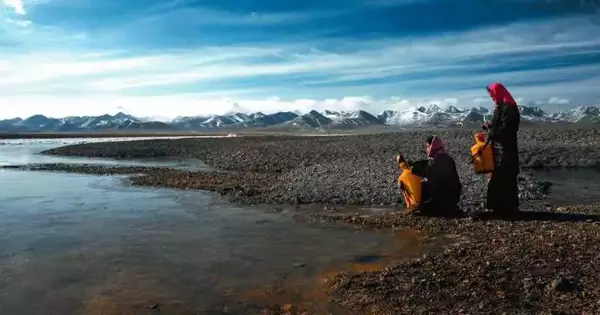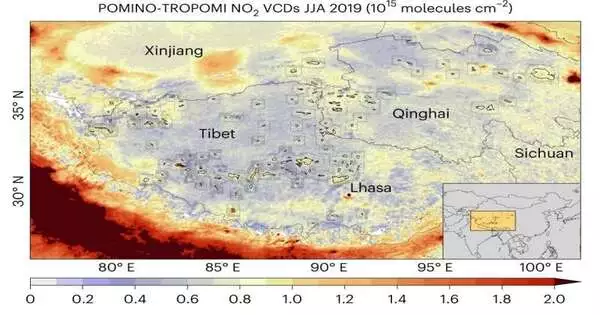In feedback loops, the atmospheric, terrestrial, hydrological, cryological (ice and snow), and biological processes of Earth’s complex systems interact with one another. Modeling their future effects, particularly with regard to climate change, necessitates an understanding of their connections.
Nitrous oxides, the third-most significant greenhouse gas after carbon dioxide and methane, are known to have an impact on the climate. Nitric oxide can come from things like power plants, cars, construction equipment, and many other things, but it also exists in lakes.
When compared to human sources, the nitric oxide in lakes has generally not been considered a significant forcing factor in air quality or climate models. However, new research published in Nature Geoscience and focusing on remote lakes on the Tibetan Plateau (where central, south, and east Asia meet) has cast doubt on this understanding.
Over 2 billion people in China, India, Pakistan, Nepal, Bhutan, Tajikistan, and Kyrgyzstan rely on the valuable water resources provided by the Tibetan Plateau, which contains thousands of lakes and accounts for approximately half of China’s lakes. These lakes are typically located in remote areas with no outflows, which results in environments that are both alkaline (with a pH value between 9 and 12) and saline (with salts and other minerals concentrated).
Using satellite observations of 135 lakes larger than 50 km2, which is the size needed for efficient use of satellite data, researchers at Peking University in China’s Laboratory for Climate and Ocean-Atmosphere Studies and their collaborators were able to record total nitric oxide emissions of 1.9 metric tons per hour, which is comparable to the emissions from global megacities. Beijing, for instance, releases 7.8 tons of nitric oxide per hour, while New York City releases 3 tons, London releases 1.7 tons, and Paris releases 0.3 tons. Additionally, it exceeded crop field emissions. Nitrogen dioxide levels were 31.2% higher in lakes located south of the Tibetan Plateau than in their immediate 20-kilometer surroundings.

A remote lake on the Tibetan Plateau from which locals collect water. Credit: Qi Wang/Unsplash
The top ten nitric oxide-emitting lakes are located in areas with the highest rates of urbanization and population growth, which contribute to the Tibetan Plateau’s warming. Extraordinarily, the emissions from Qinghai Lake were so high (0.24 tons/hour) that they are comparable to those from a coal-fired power plant with 450 megawatts of capacity.
A combination of microbial processes, warming and melting glaciers, and permafrost on the plateau have been blamed for the unusually high levels of nitric oxide in the lakes (though other sources include lightning and combustion). These processes transform nitric oxide into nitrogen dioxide in the atmosphere, specifically at the tropospheric level, which is measured by satellites and is up to 13 km above sea level on average.
Lakes on the plateau are getting bigger and more numerous as a result of the melting of ice and permafrost, which is causing summer lake warming at a rate of 0.40°C each decade. The lakes’ altitude of 4.5 to 5 kilometers above sea level makes them particularly vulnerable to the most severe impacts on glacier and permafrost degradation. According to measurements of the seasonal cyclicity of nitrogen dioxide, summer peak values were twice as high as winter peak values.
Certain bacteria thrive in these lakes’ anoxic (low oxygen) conditions by converting nitrogen from natural sources, agricultural runoff, and sewage into ammonia. This ammonia is then converted into nitrites (nitrification) and nitrogen gas (denitrification), the latter of which produces nitric oxide as a byproduct.
Because it contributes to the depletion of the ozone layer, which acts as a positive feedback mechanism for climate change, the production of nitric oxide in such large quantities is problematic. As the ozone layer turns out to be additionally harmed, more sun-based radiation can enter through the planet’s surface, warming the planet. The planet’s ever-increasing greenhouse gas layer stores heat that is released when it heats up. Instead of escaping back into space, this heat warms the planet even more, resulting in a positive feedback loop.
This report suggests that the prior perception of the importance of nitrous oxide emissions from lakes in comparison to those from anthropogenic sources needs to shift. The researchers call for including lake and inland water nitric oxide emissions in future models of global warming to help us comprehend how climate change may affect all aspects of the Earth’s system.
More information: Hao Kong et al, High natural nitric oxide emissions from lakes on Tibetan Plateau under rapid warming, Nature Geoscience (2023). DOI: 10.1038/s41561-023-01200-8





